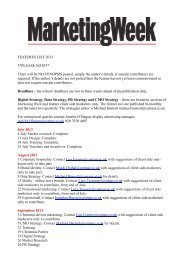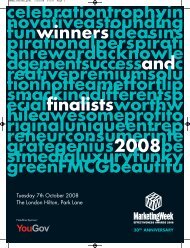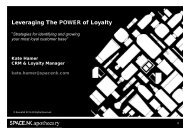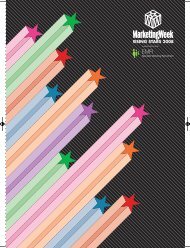Interactive Seven 2009 Supplement - Marketing Week
Interactive Seven 2009 Supplement - Marketing Week
Interactive Seven 2009 Supplement - Marketing Week
You also want an ePaper? Increase the reach of your titles
YUMPU automatically turns print PDFs into web optimized ePapers that Google loves.
MWIB_260209_p025 19/2/09 17:30 Page 25<br />
INTERACTIVE WEB 2.0<br />
Marketer’s Viewpoint<br />
Unilever UK head of new media and marketing<br />
services Rachel Bristow<br />
There is a big learning curve for brands looking to<br />
work with the likes of Bebo, Facebook and<br />
MySpace, and finding out about the best ways of<br />
communicating on a social network. Unless you<br />
can find ways of engaging people, I don’t think it<br />
can work.<br />
What is attractive about social networks is that<br />
they all have large audiences. We go to where those<br />
audiences are and run competitions and other promotions<br />
that they find engaging.<br />
For some of our brands, social networks really<br />
are relevant. It is a great way to reach 16- to 34-<br />
year-olds. For example, for Lynx we created a brand<br />
platform around the mating game. If we were to go into<br />
a social network and have a static brand page, that<br />
would fall flat on its face. You need to be interactive and<br />
entertaining. It is a mistake to go in and act like it is a<br />
TV ad and say “here’s the message” and that’s it.<br />
You need to update content, share videos and be<br />
really interactive.<br />
For a brand like Flora, I wouldn’t choose a social<br />
network. It has serious messages, so we’d be<br />
better off finding groups concerned with heart<br />
health.<br />
Social networks tend to attract the younger<br />
consumer, and one of the challenges is how to<br />
make social media attractive to the older audience.<br />
Some older people embrace social networking<br />
sites, but most prefer the telephone.<br />
It is quite difficult to get a real view of how<br />
much brands spend online, but it will be lower<br />
than other forms of media. It is set to continue to<br />
increase as online audiences grow. Proving accurately<br />
that marketing on social media is a sales<br />
driver when you are doing other media at the same<br />
time is a challenge with data protection. Tesco and<br />
Sainsbury’s, for example, can’t share data with us<br />
because consumers have not signed up to give transactional<br />
data, so you can’t see exactly who bought<br />
what. Yes, we can see a sales uplift, but we can’t see<br />
who has bought that and whether they have been<br />
exposed to the social network site.<br />
Bun fight: Burger King offered a<br />
free Whopper to Facebook users<br />
who ‘sacrificed’ ten online friends<br />
istered users worldwide and 7.3 million in the UK, is introducing two new<br />
ad services. One is “hyper-targeting”, where major advertisers can target<br />
ads at profile pages based on an in-depth analysis of the content of the page<br />
and thus the site member’s interests. The other, called MySpaceMyAds,<br />
allows SMEs to bid for key words to advertise on profile pages.<br />
A significant opportunity for brands lies in creating applications that<br />
can sit on users’ profile pages. Burger King in the US has a history of<br />
using such techniques. Its latest wheeze is a Facebook application called<br />
Whopper Sacrifice, where users are offered a free burger if they install<br />
a tool on their Facebook page which enables them to “sacrifice” or purge<br />
ten of their online friends. The campaign has led to 200,000 US Facebook<br />
friends being given the elbow and 20,000 free burgers handed out. It has<br />
proved so popular, it has been cancelled by Facebook for breaking the<br />
site’s rules on updates.<br />
An alternative to this is for brands to create their own profile<br />
pages and sign up “friends” or create their own blogs and Twitter feeds.<br />
Notable examples of successful brand pages include Topshop’s MySpace<br />
page and BlackBerry’s fan page on Facebook. This offers a downloadable<br />
application allowing users to<br />
update their Facebook pages from<br />
their phone.<br />
Another route to socialising with<br />
consumers on the web is for brands<br />
to create their own social media sites<br />
from scratch. Brands such as skincare<br />
range Simple and British Airways<br />
have created social forums to<br />
glean insights into consumer behaviour.<br />
This leads into the area of<br />
“crowd sourcing”, a form of collective<br />
problem-solving used by Dell<br />
and Google to enhance and develop<br />
products.<br />
“If the issue of intellectual property<br />
ownership can be solved, open<br />
source innovation is a great way to<br />
future-proof your brand,” says Ann<br />
Longley, interactive strategy director<br />
at MEC <strong>Interactive</strong>.<br />
Brands are also building interactivity into their own sites or creating<br />
communities to tie in with campaigns. One such initiative was created<br />
for classic oven brand Aga by digital agency Harvest Digital.<br />
The agency recommended a Google mash-up (a web application providing<br />
data from more than one source) where Aga owners could upload<br />
their photos, stories and details to a site. The agency built a website called<br />
thisismyaga.co.uk where owners were encouraged to upload their contact<br />
data to receive recipes, invitations to demonstrations and a chance<br />
to win Aga Cookshop products.<br />
The site is part of the brand’s LoveAga marketing campaign and has<br />
created a community of Aga fans. It has provided user information to<br />
the company to feed into campaigns.<br />
Online Aga saga<br />
“Brand promotion only works with social media where you have a good<br />
story,” says Harvest Digital planning director Mike Teasdale. “For Aga,<br />
we could have just built a microsite and clicked away, but the Aga site<br />
seems to have acquired a momentum of its own.”<br />
He points to other work the agency has done for National Geographic<br />
which involved putting up videos on the Daily Motion online channel.<br />
“We uploaded different videos and got 27,0000 views of the content. It’s<br />
not massive, but it doesn’t actually cost anything,” says Teasdale.<br />
Despite Facebook’s attempts to reap advertising rewards from its service,<br />
it is still a long way off making healthy margins according to observers.<br />
Some estimates say the privately-run company’s turnover hit about $150m<br />
(£108m) in 2007, more than doubling to about $300m-$350m (£216m-£252m)<br />
last year. This is for a service that claims it has 150 million active users.<br />
There have been rumours recently that Facebook is looking to acquire<br />
Twitter, the micro-blogging social network where users type in messages<br />
of 140 characters. These “tweets” are broadcast to anyone who opts to<br />
follow them.<br />
But, like much in the world of social media, the site has yet to find a<br />
way of making money from advertising and there are few signs yet that<br />
it will ever achieve this goal. But this will not stop marketers taking<br />
an optimistic view of their ability to build brands in social spaces. It<br />
may not be quite as efficient as the traditional advertising model, but it’s<br />
much more fun.<br />
<br />
<strong>Marketing</strong> <strong>Week</strong> <strong>Interactive</strong> 25








